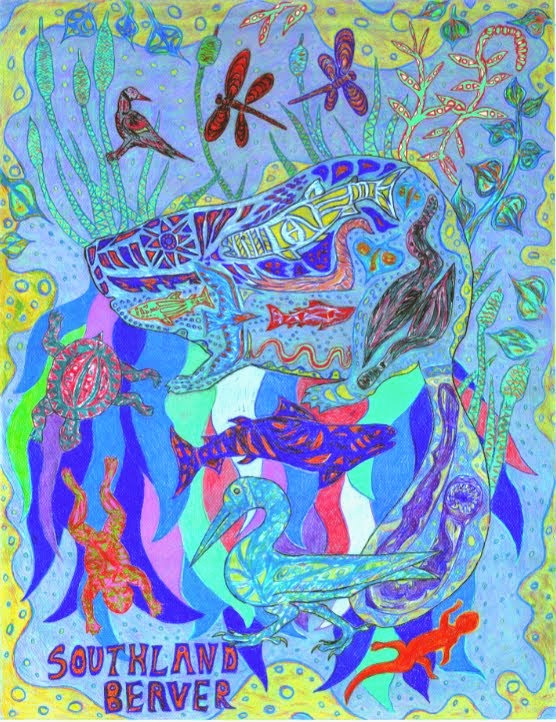It was not until I understood the three dimensional nature of water movement in our landscape that I came to understand this pattern better for what it is. Our streams and rivers, ephemeral as they may be, offer a view into water dynamics that those from wetter parts never fully get to realize.
The first useful concept to visualize is groundwater. Groundwater is a zone of saturation that lies underneath in the earth at varying depths but more or less follows the contours of the land. Wells tap into this. Ponds, rivers, lakes, marshes and other bodies of water represent the interface between the water table and the surface.
 |
| USGS (c) |
Seen three dimensionally it can be seen here how, even with no obvious signs of surface recharge, a stream can flow all year long with adequate recharge from groundwater. Such a a stream would be characterized as a "gaining" river. In our ephemeral streams this would represent the reappearance of water after a dry part or a river that flows year round.
But what is also crucial to dynamic watersheds is an understanding of aquifers. Aquifers are large subterranean bodies of water, often confined by certain layers of impervious sedimentary rocks. Many arid regions depend on withdrawing from aquifers for irrigation purposes. When these aquifers become depleted of water they want to suck it back up, either from the water table/rivers or even from the ocean (saltwater intrusion). When the aquifer is hungry it will lower the water table and deplete above ground water resources. You now have a "losing" stream and this is where rivers/streams dry up.
 |
| USGS (c) |
Seen in this manner you can visualize the above ground portion of the water table- streams, rivers, lakes etc. etc- as representing a dynamic equilibrium between above and below ground water flow. Where underground aquifers are happy, above ground flow is good and the water table is high. Where aquifers are thirsty the water table is low and above ground flow is minimal.
And at this point in our discussion, if you have been connecting the dots, it should start to crystallize in your skulls how beaver- with their ability to store water in dams and recharge aquifers slowly through the year- can transform a "losing" stream system into a "gaining" one. And this ability of beavers to create a "well watered land" is especially pivotal in arid regions.
 |
| Immature Black-Crowned Night Heron. Oxnard CA Steve Nash (c) |


It's the mechanisms that matter here. Most people only seen what's on the surface, but never consider mechanisms. Years ago back in the very early 1990s, there was a great article published in a Ranching magazine [can't remember which], that spoke about the benefits to Ranchers placing beaver on their ranches with the goal of slowing water down and causing it to back upwards and swell deep into the landscape which beavers facilitate by raising water levels. Riparian Trees are great water shunts which transport water from the immediate source of the stream, pond, lake etc hundreds of feet away to other landscape via the mycorrhizal web network.
ReplyDeleteI'm still pouring the diaries of Juan Bautista de Anza and Fray Pedro Font looking for clues about any references to beaver or possible fur trapping trades. In my Hamilton Creek post, I referenced a book called 'Around Anza Valley' by Margaret Wellman. It has a tone of historical photos of the early days of where many made a living in trapping and killing animals for their fur. The photos show a very large mount of Ringtail Cats, which are not even listed on the Chaparral Institute's list of animals, although they reference the extinct California Grizzly Bear. I have actually seen one Ringtail Cat in Burnt Valley location where I used to live in Anza CA. So there is no doubt in my mind that the Beaver were most likely trapped out.
I use to take my Son to Temecula Creek and Murrieta Creek which runs through old town Temecula. In the 1990s, there were still lots of beaver, but the authorities hated them. Last time I was there, everything was gone and the flood Channels were concrete, you know, just the way they like it ?
I was hiking once in an area of the north santa monica mountains by CSUCI when my mom saw a critter which she described as a cat like raccoon- most likely a ringtail. The area is locally famous as the "scary dairy" an old abandoned dairy farm nestled in the hills by what was once the Camarillo Mental Hospital (now CSUCI).
ReplyDeleteIn addition to beaver look out for reference to pronghorn antelope, jaguar, and wolf some of the other forgotten fauna of California.
I have done some posts on them. For example my post on the once saturated Central Valley of California from Bakersfield to Shasta. They estimate a very low minimal herd count of over 500,000. Can you imagine how such a magnificent mechanism would have managed the landscape if such a precise healthy way ? Beaver would most certainly have been present as there is a wealth of water in this area. Jaguar were not only said to have been living in the once massive Colorado River Delta sub-tropic riparian forests, but also as far north as the region of San Sebastian Marsh west of the Salton Sea where San Felipe Creek entered Lake Cahuilla.
DeleteThere is no end to the ways human idiocy shackled by green and selfishness have ruined this Earth.
-
Thanks for the posst
ReplyDelete